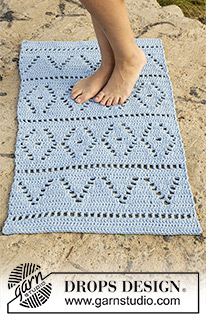Comments / Questions (27)
![]() Nyte wrote:
Nyte wrote:
Hi, I have crocheted the pattern as described and have 5 "chevron" motifs because A2 is worked 5 times in width. However the photograph of the sample carpet is with 4 repeats of A2 and with 56(+3tr and 1 turning chain) showing at the finished edge of the carpet. Are there instructions available to make the smaller carpet? Thank you!
07.09.2024 - 18:20DROPS Design answered:
Dear Nyte, you can choose to make one less repeat of A.2 and A.5, simply reduce the number of initial stitches, before starting the charts, by 14 (so by 1 repeat of the charts). Adjust the cast-on chain accordingly, as well. Happy crochetting!
08.09.2024 - 19:30
![]() Evelyn wrote:
Evelyn wrote:
Können Sie mir ungefähr sagen, wieviel Gramm Wolle ich für die Maße 120x200 benötigen würde? Vielen Dank
22.06.2024 - 11:48DROPS Design answered:
Liebe Evelyn, wir haben die Menge nur für die angegebene Maßen; da die gewünschten Mann etwa doppelt als die 1. sind, brauchen Sie wahrscheinlich ca die doppelte Garnmenge, Ihr DROPS Händler wird Ihnen damit gerne auch per Telefon oder per E-Mail weiter helfen. Viel Spaß beim Häkeln!
24.06.2024 - 08:10
![]() Sussi wrote:
Sussi wrote:
Har I ikke opskriften uden diagram?
23.05.2024 - 16:04DROPS Design answered:
Hej Sussi, det er meget let at følge diagrammet, du starter i nederst højre hjørne og hækler hver maske ifølge diagrammet, når du hækler tilbage starter du på næste række men i venstre side af diagrammet :)
24.05.2024 - 10:12
![]() Sussi Pinholt wrote:
Sussi Pinholt wrote:
Hæklet DROPS gulvtæppe i 2 tråde ”Paris” med hulmønster. Kan jeg bruge bomuld 8/4, 2 tråde?
23.05.2024 - 15:49DROPS Design answered:
Hej Sussi, hvis du vil bruge 8/4 skal du bruge 4 tråde for at holde hæklefastheden :)
24.05.2024 - 10:10
![]() Lotta wrote:
Lotta wrote:
Det är fel i A.X rad 5–10. I stället för 14 maskor så är det 15. Det är samma på rad 20, ovanför A.X. Vad gäller min fråga nedan så hittade jag svaret i en annan kommentar :)
18.03.2024 - 23:38
![]() Lotta wrote:
Lotta wrote:
Hej, stämmer det verkligen att det ska vara 87 lm (lilla storleken)? När jag virkar 6 lm och hoppar över en, så blir det bara 72 st totalt, och inte 73. Vad gör jag för fel?
15.03.2024 - 19:04DROPS Design answered:
Hej Lotta, det er svært at gætte sig til hvad som går fel, men du kan faktisk bare hækle 1 st mere, så du har hvad du skal bruge for at fortsætte :)
19.03.2024 - 12:29
![]() DUMONT Maryline wrote:
DUMONT Maryline wrote:
Modèle 170-41 Bonjour, apparemment vous ne mettez pas à combien de brides commencer le diagramme afin que cela soit bien répartit afin de centrer le point fantaisie Merci pour votre réponse
28.02.2023 - 16:17DROPS Design answered:
Bonjour Mme Dumont, suivez bien les explications pour bien placer les motifs sur vos 73-87 brides, autrement dit, crochetez ainsi: A.1 (= 2 brides), répétez ensuite 5-6 fois les 14 brides de A.2 et terminez par la bride de A.3 . Sur l'envers, lisez les diagrammes de gauche à droite en commençant par A.3, puis A.2 et terminez par A.1. Bon crochet!
28.02.2023 - 17:55
![]() Astrid wrote:
Astrid wrote:
Bonjour, J'ai fait 104 mailles en l'air, puis j'ai fait une bribe dans les deux mailles suivantes et sauté une maille, pour ensuite recommencer. Je l'ai fait 34 fois (jusqu'à la fin) et je me retrouve avec seulement 71 brides. Je ne comprends pas ce que je suis censée faire. SI vous pouviez m'aider. Merci beaucoup.
06.07.2022 - 11:44DROPS Design answered:
Bonjour Astrid, procédez ainsi: 1 bride dans la 4ème ml à partir du crochet (= 1 bride/4 ml), 1 bride dans chacune des 2 ml suivantes (= 2 brides/2 ml), puis répétez 14 fois (sautez 1 ml, 1 bride dans chacune des 6 ml suivantes), vous avez ainsi crocheté: 4+2+ (7*14)=104 ml et vous avez 1+2+ (14*6)=87 brides. Bon crochet!
06.07.2022 - 14:20
![]() Mirella wrote:
Mirella wrote:
Non riesco a capire come devo procedere con il primo giro, cosa significa Lavorare la prima riga come segue: 1 m.a nella 4a cat dall’uncinetto (= 1 m.a e 3 cat per girare il lavoro), 1 m.a in ognuna delle 6-2 cat successive, . Cosa significa il -2cat.? Grazie infinite
08.12.2021 - 11:32DROPS Design answered:
Buongiorno Mirella, i numeri doppi tipo 6-2 indicano i numeri di maglie per le diverse taglie, in questo caso 6 catenelle per la taglia più piccola e 2 catenelle per quella più grande. Buon lavoro!
08.12.2021 - 18:10
![]() Pirjo wrote:
Pirjo wrote:
Bonjour, Je voudrais réaliser ce modèle avec Drops loves you 7. Combien de pelotes me faudrait-il pour avoir à peu près la même épaisseur ? Je vois que dans ce modèle on utilise Drops Paris en double avec un crochet n°6. Me faudrait-il tripler Drops loves you7 pour la crocheter avec le n°6? Amicalement Pirjo
17.06.2021 - 18:14DROPS Design answered:
Bonjour Mme Pirjo, comme DROPS loves you 7 est du groupe A (= 2 fils groupe A = 1 fil groupe C), vous remplacerez ici 2 fils DROPS Paris par 4 fils DROPS loves you 7, vous trouverez ici comment calculer la nouvelle quantité. Bon crochet!
18.06.2021 - 07:40
Boardwalk#boardwalkrug |
||||||||||||||||||||||||||||
 |
 |
|||||||||||||||||||||||||||
Crochet DROPS rug with lace pattern in 2 strands "Paris".
DROPS 170-41 |
||||||||||||||||||||||||||||
|
CROCHET INFO: At beg of every row with dc work 3 ch to turn with. These 3 ch do not replace first dc. At beg of every row with tr work 4 ch to turn with. These 4 ch do not replace first tr. PATTERN: See diagrams A.1 to A.6. ---------------------------------------------------------- RUG: Work 87-104 ch (includes 3 ch to turn with) on hook size 6 mm / J/10 with 2 strands Paris. Work first row as follows: Work 1 dc in 4th ch from hook (= 1 dc and 3 ch to turn with), 1 dc in each of the next 6-2 ch, * skip ch 1, work 1 dc in each of the next 6 ch *, repeat from *-* 10-13 more times = 73-87 dc. Now work pattern from 2nd row in diagram as follows - READ CROCHET INFO: Work A.1 (= 2 dc), A.2 (= 14 dc) 5-6 times in width, A.3 (= 1 dc). When entire A.1-A.3 has been worked vertically, continue from 1st row with A.4 over A.1, A.5 over A.2 and A.6 over A.3. REMEMBER THE CROCHET GAUGE! When A.X has been worked 1 time vertically, repeat A.X 1-2 more times vertically. Piece measures approx. 77-101 cm / 30½"-39 3/4". Continue with the remaining 9 rows in A.4-A.6. Now work the last 2 rows in A.X, then work 2 rows with 1 dc in every dc. Piece measures approx. 100-123 cm / 39½"-48½" in length. Fasten off. |
||||||||||||||||||||||||||||
Diagram explanations |
||||||||||||||||||||||||||||
|
||||||||||||||||||||||||||||

|
||||||||||||||||||||||||||||

|
||||||||||||||||||||||||||||
Have you finished this pattern?Tag your pictures with #dropspattern #boardwalkrug or submit them to the #dropsfan gallery. Do you need help with this pattern?You'll find 7 tutorial videos, a Comments/Questions area and more by visiting the pattern on garnstudio.com. © 1982-2025 DROPS Design A/S. We reserve all rights. This document, including all its sub-sections, has copyrights. Read more about what you can do with our patterns at the bottom of each pattern on our site. |
||||||||||||||||||||||||||||
















































Post a comment to pattern DROPS 170-41
We would love to hear what you have to say about this pattern!
If you want to leave a question, please make sure you select the correct category in the form below, to speed up the answering process. Required fields are marked *.